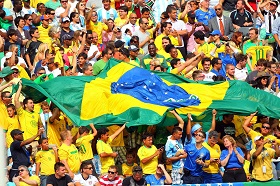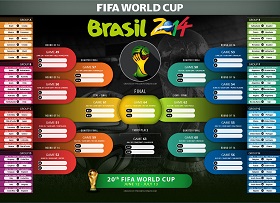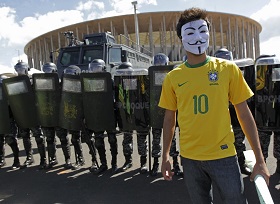Mundial 2014: Brazil is More than Soccer
(no votes) |
(0 votes) |
PhD (Political Science), Senior Research Fellow, RAS Institute for Latin American Studies
The FIFA World Cup finals underway in Brazil are capturing the attention of both soccer fans and big business worldwide. While on the one hand there are clear economic dividends, the host state also faces social and even political problems. Brazil’s trial-and-error approach could be quite instructive for Russia, which is already preparing to host the 2018 championship.
The FIFA World Cup finals underway in Brazil are capturing the attention of both soccer fans and big business worldwide. While on the one hand there are clear economic dividends, the host state also faces social and even political problems. Brazil’s trial-and-error approach could be quite instructive for Russia, which is already preparing to host the 2018 championship.
Globalization and World Soccer
While track and field is believed to be the queen of sports, soccer is obviously the king, the only sport that has evolved into a lucrative international business. The World Cup is a major event both for the game and for international trade, while the venues attract both top players and top national and transnational corporations. Quite symbolically and by no means incidentally, the opening match took place not in Brasilia, the country's capital, not Rio de Janeiro, its tourist center, but in Sao Paulo, South America's largest metropolis and business hub.
As a rule, the international economic aspects of the soccer world championships are rarely covered in the media, but ignoring their importance hinders our ability to construct an integral and objective picture of the world economy. And soccer is the most globalized sport across the world.
Despite potential and often inevitable socio-economic costs, the game seems worth the investment.
Transnational corporations are the key actors in the overall processes of globalization and compete even with large national economies. As a result, the Fédération Internationale de Football Association or FIFA is often seen not just as a regular international organization but rather as a sort of transnational sports corporation alongside Nike, Adidas, Reebok or Puma. At that, many TNCs – Coca-Cola, Adidas, Sony, Visa, Hyundai, et al – are associated with FIFA through which they promote their business interests. While sports-oriented TNCs usually produce equipment or supply food products, FIFA provides a full spectacle, with the World Cup and other international tournaments becoming temporary corporate headquarters. Such parallels are well justified, as well-known Uruguayan author and publicist Eduardo Galeano even has said that "the FIFA is the IMF of football."
The game provides the leading soccer power with a palpable post-crisis pop. For example, Spain, the World Cup holder from 2010 until now, is using the soccer economy as an additional buffer against the consequences of its economic slump. Football generates 1.7 percent of its GDP or about nine billion euro annually (the soccer lottery only brings 500 million euro a year), plus is responsible for about 85,000 jobs.
Here are some soccer-related global economic indicators. According to the Financial Action Task Force, there are 38 million registered professional players number and five million referees and managers, making the soccer empire demographically comparable with a medium-size country. If you add in amateurs, the figure rises to 270 million or four percent of the world's population.
Deloitte rates soccer as the 17th-largest global economy, its total capital reaching USD 500 billion, surpassing such solid economies as Argentina, Peru, Chile, New Zealand, Austria and Colombia. While the UN places the economic weight of sports at three percent of global GDP, the share of world soccer accounts for 0.7 percent. Of course, these figures are mostly estimates that deserve some degree of skepticism, but despite the metaphor, they are striking in size and reflect the real magnitude of soccer's global significance.
Hence, a country’s World Cup qualification signifies participation in a major process of globalization. Despite potential and often inevitable socio-economic costs, the game seems worth the investment. Brazil's experience graphically shows that the end result of the pros and cons obviously involves opening new opportunities for national development.
World Cup Organization Brazilian-Style
President Lula da Silva promised to make the championship the best in history, although now it ranks just as the costliest.
When the Brazilian application for the World Cup was approved in 2007, then-president Lula da Silva promised to make the championship the best in history, although now it ranks just as the costliest. Stadium construction and modernization expenses tripled initial estimates, reaching USD 3.68 billion. For Germany in 2006 the same figure was USD 1.87 billion and the RSA in 2010 – USD 1.48 billion. According to official data that includes expenditures on airports, roads, etc., Brazil has spent USD 11 billion, although many analysts insist that total expenditures are much higher. And it this the overspending that is the key driver behind discontent in Brazilian society, which believes that the money could have been allocated to solving urgent social problems like urban infrastructure, especially energy supplies, education, healthcare or housing construction since one-third of Rio residents live in slums.
The expenditures were not only federal in nature, with 80 percent coming from the government and the rest from private investors. FIFA also allocated USD 1 billion, which is not too onerous for the organization that normally earns about USD 5 billion from each World Cup four-year cycle.
The construction of the sports and transportation infrastructure encountered many problems as the commissioning of some facilities had to be delayed and even put on hold, sometimes because of tragic incidents that provided fuel for skeptics predicting failure in the country’s preparation. Brazilian media has been frequently set alit by corruption scandals. As a matter of fact, one of the Brazilian traits is procrastination, so optimists were sure that all facilities would be ready in time despite the delays and shortages.
Security is a priority during any large sporting event, and Brazil had to pay a high price to ensure the safety of fans and participants. Federal allocations in this area made up about USD 33.3 million to each of the 12 host cities, with an entire police-based security program amounting to USD 400 million. These huge sums have been definitely justified by the risk of damage done to international image of the World Cup venue. In order to increase efficiency, Brazil has set up the National Joint Control and Command Center to coordinate the activities of emergency medical aid, civilian defense, federal, municipal and road police and other security services. In actuality, the center brings together law enforcement agents from all 32 countries participating in the championship.
Furnished with state-of-the-art security systems, the World Cup is often cited in the press as the technological leader in the FIFA history, with Hermes 900 and Hermes 450 drones by Israeli company Elbit Systems Ltd hovering above the stadiums to monitor movements online and transmit data at 50 MB per second. One more technological breakthrough is the transmission of several games in the 4K digital format by SONY.
Cybersecurity has become a priority alongside traditional security measures.
This summer offers a serious test for Brazilian cybersecurity. Only one week before the championship, Anonymous attacked Brazil's foreign ministry website, which resulted in leaked documents on the World Cup’s technical security. Hackers threaten to take further action, hinting at cyber-terror during the tournament. Hence, cybersecurity has become a priority alongside traditional security measures. The Israeli company Risco provided monitoring equipment and installed it at stadiums, charging Brazil USD 2 million for its services. Additional steps have been taken to enhance the protection of the government websites from cyber attacks.
Brazil's Economic Bonuses and Legal Concessions
A vanity fair for sportsmen, the World Cup is a battleground for foreign corporations. Apex-Brazil, i.e. Brazilian Trade and Investment Promotion Agency, which represents FIFA's local interests, has announced that the tournament is flooded with over 700 private firms from 104 countries advancing their brands, goods and services. The Brazilian budget will earn over USD 9 billion through investments, trade and taxes (its economic bonus from the 2013 Confederations Cup was USD 3 billion). Brazil is more than football is slogan behind the advertising campaign aimed to attract foreign investors.
In order to attract external financing and effectively realize the World Cup’s economic potential to develop the nation, Brasilia had to amend and modernize existing laws. In 2012, there was a lot of hype around the Fundamental Law of the Championship, dubbed the FIFA Law by the press and fervently debated in the Senate. Recognized as valid by the Supreme Federal Court after multiple tests of its constitutionality, the law provides the basis for the commercial activities of FIFA and associated TNCs in Brazil, as well as includes measures for easing foreign trade during the World Cup, for example beer sales at stadiums where were normally prohibited since 2003. In view of international law, the act adapts the domestic legal space to external interests, only further justifying criticism on the part of those who believe that national sovereignty must prevail.
On the whole, hosting the World Cup is good for a national economy by attracting foreign capital, creating jobs, and stimulating consumer demand and tourism. Late 2013 forecasts indicated that the event would improve Brazil’s macroeconomic figures, by generating a 2.17-percent GDP growth rate over the 2010-2014 period.
Preparations for the 2014 World Cup and 2018 Olympics have tapped huge investment potential which was hardly employable by Brazil on its own. Major events require both the construction of sports facilities and the modernization of associated infrastructure, thus making sports the reason behind focusing attention on other sectors of the economy. To this end, last February Brasilia launched a formidable infrastructure program aimed at laying 7,500 km of highways and about 10,000 km railways including a high-speed railway track between Rio de Janeiro and Sao Paulo, as well as building two international airports. The projects’ total cost reached USD 212 billion, opening up broad opportunities for foreign investors, as the government offered palpable tax benefits.
In order to attract external financing and effectively realize the World Cup’s economic potential to develop the nation, Brasilia had to amend and modernize existing laws.
The World Cup has brought Brazil a number of innovation and technology advantages, since companies regard the soccer championship, just like any other major sporting competition, as a sort of showcase for their achievements. Tech corporations normally find it very attractive to participate both in financing and equipping international events. For instance, the YingliSolar, a Chinese solar energy firm, has installed 1,500 solar batteries at Maracana Stadium, the venue for seven games including the final, in order to provide it with offline power supply. As a result, NGOs are widely praising this year’s World Cup as the most environmentally safe championship in soccer history.
Socio-Economic and Political Risks
The World Cup’s socio-economic effects have actually been zero, with the minuses effectively eliminating all the pluses. The preparations have generated 250,000 jobs, while the media interpreted the same figure, no matter how strange it may seem, through the lens of people whose rights have been infringed through forcible resettlement, excessive exploitation of labor, etc. during the same process. And social issues have triggered public discontent in Brazil only underlining the importance of state-wide instruments for alleviating and compensating for social risks.
As far as Brazil is concerned, one should bear in mind the effects of last year’s mass protests, among other things caused by the FIFA Confederations Cup. According to Director of RAS Institute for Latin American Studies Vladimir Davydov, “the unrest was caused by good rather than by bad living conditions, i.e. by heightened expectations.” The World Cup can easily raise societal expectations and at the same time bring people more dissatisfaction. The Brazilian public consciousness has accumulated a host of socio-economic worries and a hefty portion of the population tends to perceive the event as a feast in time of plague, since the glossy and trouble-free TV images sharply contrast with everyday life.
Both the Brazilian and future Russian World Cups have a tense political backdrop, with presidential elections in Brazil occurring three months after the event and in Russia three months before the soccer event will take place in 2018. Bearing in mind the importance of emotions, Brazil’s political risks appear much higher, since the soccer feast here becomes a key psychological factor for the turnout and voting. Although Dilma Rousseff’s ratings appear high enough for easy reelection, the soccer results inevitably will play an important role. In addition, the opposition is still eager to launch a social protest wave during the championship that could turn the event more political and at the same time more confused. As such, the fact that the Russian elections will be held prior to the championship appears to carry fewer political risks.
***
By holding the two successive World Cups, Russia and Brazil may well obtain extra cause for advancing their bilateral relationship and also indirectly strengthening ties within the BRICS. Preparing for the event, Moscow may draw upon such Brazilian practices as building bridges with businesses, including foreign companies, and attracting investments and modernization technologies, and optimizing sports and associated infrastructures (transportation, tourism, etc.). Brazil has already worked hard in negotiations with the rigorously commerce-oriented FIFA, something Russia still has to do. And Brasilia’s experiences with compromise and even concessions like amending the national law do seem useful, as well as all the negative aspects that could provide instructive lessons. Overall skepticism and criticism about Brazil’s ability to organize the championship sometimes jeopardized the country’s international image. In this light, an analysis of errors and miscalculations could greatly help to make the preparations for an event of such global significance more efficient. Each World Cup is known to raise the technological ante both for sports and security, making the Russia-Brazil relationship absolutely essential in view of Mundial 2018. Exchanging symbolic capital, i.e. the organizational and information systems for putting together the Cup, the two countries could also grow closer through improved capital exchanges and trade. Currently, the South American giant is unquestionably Russia’s biggest partner, though there is much room for improvement.
(no votes) |
(0 votes) |








